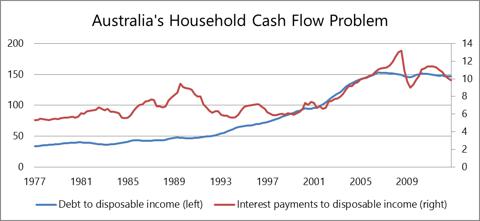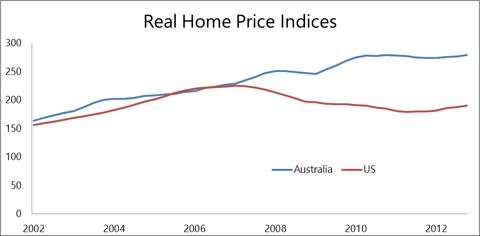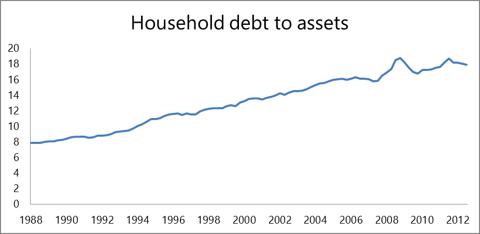The Australian housing bubble is looking to be a bigger problem for that country than the U.S.' was in 2008-09. Australia differs from the U.S. both in terms of relative economic conditions and the health of its property markets. The mountain of debt is Australia is mostly private - housing - and dwarfs public-sector debt.
Australians have gone heavily into debt to buy houses that cost more than ever, especially the land component; and there's no sign this trend will end anytime soon. Mortgage debt has more than quadrupled from 19% of GDP in 1990 to 84% in 2012-- as high as that of the U.S. at its peak where mortgage debt as a percentage of GDP has fallen from 86% in 2009 to 68% in 2012. Negative gearing and easy lending combined to push house prices higher. Looking at affordability as a function of disposable income, both the ratio of total debt and interest payments to disposable income are very high - see the chart below. Widespread mortgage fraud to gain bank credit is asserted by Denise Brailey, the president of the Banking and Finance Consumer Support Association (an organization dedicated to protecting the public against predatory financiers).
The government's privatized and deregulated retirement system is the leading cause. Do-it-yourself superannuation funds - a kind of government-mandated retirement account replete with 401K-style matching -- enter this market and avoid capital gains tax, which has created an enormous pool of available loan capital. The Reserve Bank of Australia (The RBA) cut rates this May to push the housing market further, after a February to March rise by 5.2% in loans to owner-occupiers, according to new bureau of statistics figures.
The high capital gains tax system helps to feed this by people holding onto their houses as opposed to selling them. Worse, the return after paying capital gains tax is less than the return on rent for investment houses, which further reduces supply and puts upward pressure on prices. Contrary to the U.S.' sharp fall in home prices after the peak in June 2007, Australia's has kept climbing up to an index (1986 starting point) of 279.2 at the end of 2012. It is forecasted at 3-5% growth nationally, 2-8% growth for Sydney.
Dr. Ellis of the Reserve Bank of Australia warned that lowering financing standards to boost loan growth has lead to massive negative equity in the market. Besides, much of this lending has been financed from abroad, so the key risk is in the banks' ability to refinance their borrowings. Australia's household debt to household assets rose to 18% at the end of last year. Under the disaster scenario, with banks trying to repay foreign creditors and a decline in economic growth, Australia's banks and housing sectors would be very hard hit.
Figure 3
Australia's economy is experiencing increasing reliance on overseas funding, becoming more interlinked with China's growth and business cycle. The Chinese economy grew at 7.8% GDP in 2012, the slowest since 1999, and an increase in global commodity supplies could cause a sharp reduction in Australia's incomes and employment. Australia linked up with China in direct currency trading in March and this puts the country in a tenuous position if trade between the two countries slowed dramatically and would prompt a severe correction of home prices which some feel could take price all the way back to the 1990's.
Why would this be a real problem? Because much of the immigration into Australia recently has been Chinese. Chinese property buyers are choosing Australia in increasing numbers, and their decision is not driven by rental yields or hopes for future capital gains. For Chinese buyers it's not only about price. Australia is the second most favored destination for Chinese buyers of overseas property because many want their children educated in Australia, fleeing the Chinese public and university systems. It has caused some of the recent overpricing in Australia's housing market, which has continued well beyond what economists feel is the equilibrium price for dwellings - by 30% to 40%
So, it is very possible that if the current softness in the global economy continues to deteriorate, and that is a very likely occurrence, then Australia's property bubble will burst, having a huge affect on Australian ETFs. MSCI Australia Index Fund Holding (EWA), with 42% exposure to financial services and 6.9% in real estate sector, will keep growing as long as the global equity rally continues. It currently pays investors a 4.97% dividend yield, which compares favorably to the 2.41% of the Vanguard REIT ETF (VNQ). Australian REITs, after their second-best year on record, will continue to be strong through 2013 through M&A activity and divesting themselves of overseas assets. The S&P/ASX REIT Index had its largest outperformance on record in 2012 with a total return of 33% in 2012 and is predicted to gain 15% this year, according to CLSA's forecast.
The rate cut by the RBA was widely believed to be done to support flailing mining and commodity sectors, but it is much more likely that it was due to the need to keep pumping up the housing market and alleviate the rising cash flow problems of the average Aussie wage-earner. The move in the Australian Dollar (FXA) has likely been way overdone and but with it unable to even regain $0.97 the short-term looks bearish. A turn in the Australian dollar would begin to signal that the market does not believe the Fed will back off QE in 2013. But, if that does not happen and the Fed attempts to defend the dollar at all costs look out below down under.



Comments